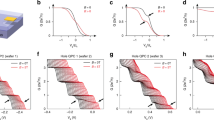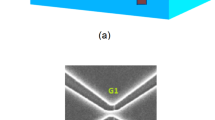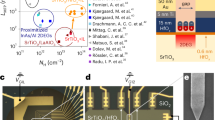Abstract
Quantum point contacts are narrow, one-dimensional constrictions usually patterned in a two-dimensional electron system, for example by applying voltages to local gates. The linear conductance of a point contact, when measured as function of its channel width, is quantized1,2,3 in units of GQ = 2e2/h, where e is the electron charge and h is Planck’s constant. However, the conductance also has an unexpected shoulder at ∼0.7GQ, known as the ‘0.7-anomaly’4,5,6,7,8,9,10,11,12, whose origin is still subject to debate11,12,13,14,15,16,17,18,19,20,21. Proposed theoretical explanations have invoked spontaneous spin polarization4,17, ferromagnetic spin coupling19, the formation of a quasi-bound state leading to the Kondo effect13,14, Wigner crystallization16,20 and various treatments of inelastic scattering18,21. However, explicit calculations that fully reproduce the various experimental observations in the regime of the 0.7-anomaly, including the zero-bias peak that typically accompanies it6,9,10,11, are still lacking. Here we offer a detailed microscopic explanation for both the 0.7-anomaly and the zero-bias peak: their common origin is a smeared van Hove singularity in the local density of states at the bottom of the lowest one-dimensional subband of the point contact, which causes an anomalous enhancement in the Hartree potential barrier, the magnetic spin susceptibility and the inelastic scattering rate. We find good qualitative agreement between theoretical calculations and experimental results on the dependence of the conductance on gate voltage, magnetic field, temperature, source–drain voltage (including the zero-bias peak) and interaction strength. We also clarify how the low-energy scale governing the 0.7-anomaly depends on gate voltage and interactions. For low energies, we predict and observe Fermi-liquid behaviour similar to that associated with the Kondo effect in quantum dots22. At high energies, however, the similarities between the 0.7-anomaly and the Kondo effect end.
This is a preview of subscription content, access via your institution
Access options
Subscribe to this journal
Receive 51 print issues and online access
$199.00 per year
only $3.90 per issue
Buy this article
- Purchase on Springer Link
- Instant access to full article PDF
Prices may be subject to local taxes which are calculated during checkout



Similar content being viewed by others
References
van Wees, B. J. et al. Quantized conductance of point contacts in a two-dimensional electron gas. Phys. Rev. Lett. 60, 848–850 (1988)
Wharam, D. A. et al. One-dimensional transport and the quantisation of the ballistic resistance. J. Phys. C 21, L209–L214 (1988)
Büttiker, M. Quantized transmission of a saddle-point constriction. Phys. Rev. B 41, 7906(R) (1990)
Thomas, K. J. et al. Possible spin polarization in a one-dimensional electron gas. Phys. Rev. Lett. 77, 135–138 (1996)
Appleyard, N. J. et al. Direction-resolved transport and possible many-body effects in one-dimensional thermopower. Phys. Rev. B 62, R16275–R16278 (2000)
Cronenwett, S. M. et al. Low-temperature fate of the 0.7 structure in a point contact: a Kondo-like correlated state in an open system. Phys. Rev. Lett. 88, 226805 (2002)
DiCarlo, L. et al. Shot-noise signatures of 0.7 structure and spin in a quantum point contact. Phys. Rev. Lett. 97, 036810 (2006)
Koop, E. J. et al. The influence of device geometry on many-body effects in quantum point contacts: signatures of the 0.7-anomaly, exchange and Kondo. J. Supercond. Nov. Magn. 20, 433–441 (2007)
Sarkozy, S. et al. Zero-bias anomaly in quantum wires. Phys. Rev. B 79, 161307R (2009)
Ren, Y. et al. Zero-bias anomaly of quantum point contacts in the low-conductance limit. Phys. Rev. B 82, 045313 (2010)
Micolich, A. P. What lurks below the last plateau: experimental studies of the 0.7 × 2e2/h conductance anomaly in one-dimensional systems. J. Phys. Condens. Matter 23, 443201 (2011)
Burke, A. et al. Extreme sensitivity of the spin-splitting and 0.7 anomaly to confining potential in one-dimensional nanoelectronic devices. Nano Lett. 12, 4495–4502 (2012)
Meir, Y., Hirose, K. & Wingreen, N. S. Kondo model for the 0.7 anomaly in transport through a quantum point contact. Phys. Rev. Lett. 89, 196802 (2002)
Rejec, T. & Meir, Y. Magnetic impurity formation in quantum point contacts. Nature 442, 900–903 (2006)
Ihnatsenka, S. & Zozoulenko, I. V. Conductance of a quantum point contact based on spin density-functional theory. Phys. Rev. B 76, 045338 (2007)
Matveev, K. A. Conductance of a quantum wire at low electron density. Phys. Rev. B 70, 245319 (2004)
Reilly, D. J. Phenomenological model for the 0.7 conductance feature in quantum wires. Phys. Rev. B 72, 033309 (2005)
Sloggett, C. Milstein, A. I. & Sushkov, O. P. Correlated electron current and temperature dependence of the conductance of a quantum point contact. Eur. Phys. J. B 61, 427–432 (2008)
Aryanpour, K. & Han, J. E. Ferromagnetic spin coupling as the origin of 0.7 anomaly in quantum point contacts. Phys. Rev. Lett. 102, 056805 (2009)
Güçlü, A. D. et al. Localization in an inhomogeneous quantum wire. Phys. Rev. B 80, 201302(R) (2009)
Lunde, A. M. et al. Electron-electron interaction effects in quantum point contacts. New J. Phys. 11, 023031 (2009)
Goldhaber-Gordon, D. et al. Kondo effect in a single-electron transistor. Nature 391, 156–159 (1998)
Oguri, A. Transmission probability for interacting electrons connected to reservoirs. J. Phys. Soc. Jpn 70, 2666–2681 (2001)
Andergassen, S. et al. Renormalization-group analysis of the one-dimensional extended Hubbard model with a single impurity. Phys. Rev. B 73, 045125 (2006)
Karrasch, C., Enss, T. & Meden, V. Functional renormalization group approach to transport through correlated quantum dots. Phys. Rev. B 73, 235337 (2006)
Metzner, W. et al. Functional renormalization group approach to correlated fermion systems. Rev. Mod. Phys. 84, 299–352 (2012)
Nozières, P. A “fermi-liquid” description of the Kondo problem at low temperatures. J. Low Temp. Phys. 17, 31–42 (1974)
Glazman, L. &. Pustilnik, M. in Nanophysics: Coherence and Transport (eds Bouchiat, H. et al.) 427–478 (Elsevier, 2005)
Mourik, V. et al. Signatures of Majorana fermions in hybrid superconductor-semiconductor nanowire devices. Science 336, 1003–1007 (2012)
Meir, Y. & Wingreen, N. S. Landauer formula for the current through an interacting electron region. Phys. Rev. Lett. 68, 2512–2515 (1992)
Acknowledgements
We thank B. Altshuler, P. Brouwer, R. Egger, J. Folk, L. Glazman, V. Golovach, A. Hamilton, A. Högele, Y. Imry, M. Kiselev, J. Kotthaus, D. Logan, D. Loss, C. Marcus, Y. Meir, H. Monien, M. Pepper, M. Pustilnik, A. Rosch, K. Schönhammer, B. Spivak and A. Yacoby for discussions, and, in particular, S. Andergassen, C. Honerkamp, S. Jakobs, C. Karrasch, V. Meden, M. Pletyukhov and H. Schoeller for FRG-related help and advice. We acknowledge support from the DFG through SFB-631, SFB-TR12, De730/3-2, De730/4-1, De730/4-2, De730/4-3, HO 4687/1-3, LU819/4-1 and the Cluster of Excellence Nanosystems Initiative Munich; from the Center for NanoScience; and from the US National Science Foundation under grant no. NSF PHY05-51164. S.L. acknowledges support through a Heisenberg fellowship of the DFG.
Author information
Authors and Affiliations
Contributions
J.v.D. and S.L. coordinated the project: J.v.D. initiated and supervised the theoretical work, and S.L. planned and supervised the experiments and their analysis. F.B. and J.H. carried out the calculations using FRG, and J.H., F.B. and B.B. carried out the calculations using perturbation theory. D.S. and W.W. provided the wafer material, and D.B. fabricated the nanostructure. E.S., D.B., D.T. and S.L. carried out the measurements, and E.S., D.B., F.B. and J.H. carried out the experimental data analysis. J.H. and F.B. prepared the figures, and J.v.D., S.L., F.B., J.H. and E.S. wrote the paper.
Corresponding authors
Ethics declarations
Competing interests
The authors declare no competing financial interests.
Supplementary information
Supplementary Information
This file contains Supplementary Text, Supplementary Figures 1-18, Supplementary Tables 1 and Supplementary References. (PDF 1540 kb)
Rights and permissions
About this article
Cite this article
Bauer, F., Heyder, J., Schubert, E. et al. Microscopic origin of the ‘0.7-anomaly’ in quantum point contacts. Nature 501, 73–78 (2013). https://doi.org/10.1038/nature12421
Received:
Accepted:
Published:
Issue Date:
DOI: https://doi.org/10.1038/nature12421
This article is cited by
-
One-dimensional Kronig–Penney superlattices at the LaAlO3/SrTiO3 interface
Nature Physics (2021)
-
New signatures of the spin gap in quantum point contacts
Nature Communications (2021)
-
Robust quantum point contact via trench gate modulation
Scientific Reports (2020)
-
Interacting topological edge channels
Nature Physics (2020)
-
Spin-momentum locked spin manipulation in a two-dimensional Rashba system
Scientific Reports (2019)
Comments
By submitting a comment you agree to abide by our Terms and Community Guidelines. If you find something abusive or that does not comply with our terms or guidelines please flag it as inappropriate.



